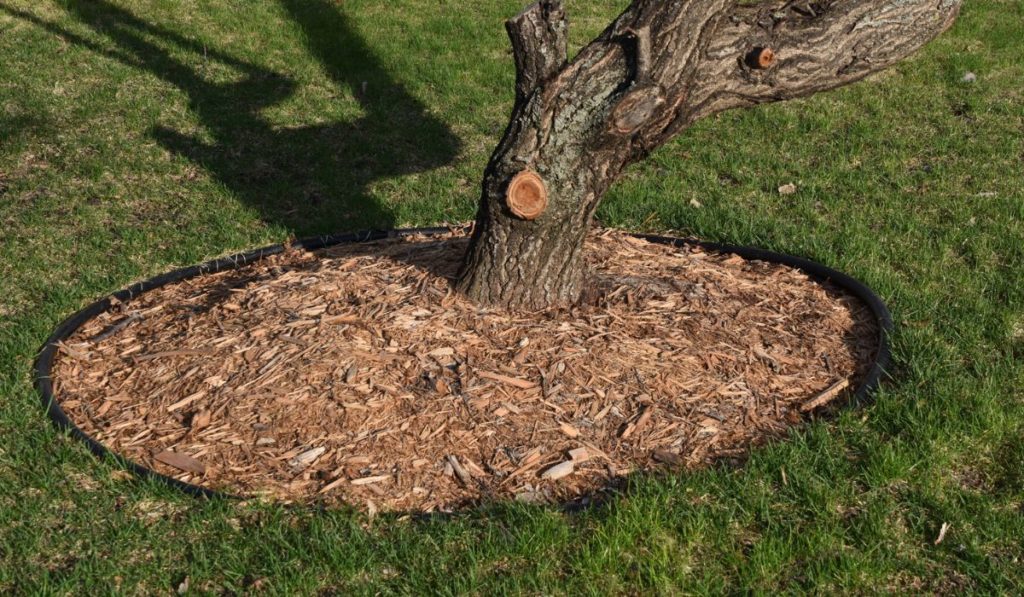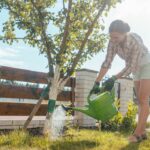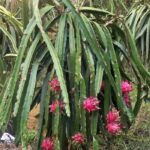Every fruit tree needs mulch to foster its growth and produce juicy fruits. However, you can’t just use any old mulch out there. So, which mulch types are best for fruit trees?
The best kind of mulch for fruit trees varies by the type of tree. Generally, organic mulches like wood clippings and straw are preferred, as they form a natural covering that provides various benefits to a developing tree, but some mulches pair better with citrus trees than, say, an Apple tree.
Mulch may seem relatively straightforward to use and highly beneficial, but that’s not always the case. Even the best mulches have some potential downsides and should be used with care. Let’s take a look at what mulch is, which types to consider, and how to use mulch to help your fruit trees prosper.
Should You Put Mulch Around Your Fruit Trees?

Yes, putting mulch around your fruit trees is a highly recommended practice that can be done any time of the year. Mulching is a unique technique that agriculturists should adopt no matter what crop they grow.
As remarkable as mulch can be, it also has some downsides and risks. Let’s take a look at the pros and cons.
Pros of Using Mulch
- Straw mulch on fruit trees prevents berries from touching the soil. This enables the berries to remain clean and free of dirt.
- Some mulches improve the soil structure, which in turn provides a conducive soil environment for the fruit tree’s healthy root growth.
- Natural cedar mulch has insect repellant features that deter ants and termites from the fruit tree.
- Mulching fruit trees improves soil structure, texture, and pH balance.
- It prevents fruit trees from losing moisture, ensuring they don’t wither.
- The soil temperature is constantly regulated when you mulch any fruit tree.
Cons of Using Mulch
- Ramial mulches (see more discussion this term below) on fruit trees steal nitrogen from the soil in the first year, so you have to layer it on top of manure to ensure your fruit tree has access to nutrients in the short term.
- Mulches with high carbon to nitrogen ratio may cause a nitrogen shortage in plants.
- Applying shredded paper to mulch fruit trees doesn’t provide as much nutrition to the soil as organic mulches.
- Mulching with straw and living mulches attract pests like rodents that damage the trees’ roots and bark.
- Wood mulch used on its own prevents the proper growth of fruit trees, particularly the young trees.
- Pine mulch makes the soil more acidic, and fruit trees don’t flourish well in strongly acidic soils.
- The dyes used for colored mulch can seep into the ground if you mulch your fruit trees with them.
- It takes years for bark mulch to provide nutritional benefits to the earth and fruit tree as they have a slow decomposing rate.
What Kind of Mulch Is Best for Fruit Trees?
The best mulch for fruit trees is organic mulch. Inorganic mulch, which does not decompose over time, prevents fruit trees from getting the nutrients they need.
As for the organic mulches, it’s best to stick with the natural environment the fruit tree grows in, as leaves and fruits naturally fall from trees to cover the earth.
In areas with acidic soils, the acidity may need to be minimized for fruit trees that thrive in alkaline soils. Highlighted below are excellent mulches that work well with varieties of fruit trees.
Mulch for Fleshy Fruits
Trees that bear fleshy fruits like apples, pears, and peaches need mulch that can produce nutrients for long periods. Such mulch must be capable of resisting the moisture and wet weather conditions that the fruit trees flourish under, like the apple orchards of the rainy Pacific Northwest.
The most suitable mulch for fleshy fruits is bark or hardwood mulch, which is durable and readily decomposes to replenish soil nutrients. Additionally, this mulch effectively reduces soil acidity as it naturally increases pH over time. This makes it great for fruit trees that thrive in neutral or alkaline soil.
Bark mulch also works perfectly in wet weather conditions and breaks down better in wet environments. This mulch is generally made from softwood or hardwood trees and can easily be found in lawn and garden facilities.
Mulch for Citrus Fruits
Citrus fruit trees require unique mulches that would undoubtedly be harmful to other tree types as they benefit from acidic soils and are organically resilient in such soils. Good examples of fruit trees that produce fruits high in citric acids are orange and lemon trees.
Such fruit trees grow well with mulch made of pine needles and mashed pine cones due to the essential nutrients they release into the soil. You can find these mulches easily since pine needles and cones are readily accessible. To create the mulch, just place a few inches of pine needles around the tree base, and they’ll generate more than enough mulch supply for nearly a year.
Mulch for Tropical Fruits
Every tropical fruit tree like papaya and passion fruit needs mulch capable of quickly replenishing nutrients faster than other trees. The mulch must be very rich in organic matter as tropical fruit trees absorb nutrients from the soil much faster than other trees.
The appropriate mulch for tropical fruit trees is a combination of grass or straw mixed with organic manure like cow excrement. This matter will disintegrate into the soil at a super-fast rate and will be replenished every three to four months. Some fruit farmers find adding chopped fish to the mulch very helpful in increasing the mixture’s effectiveness.
Nutrient-Rich Fruit Tree Mulches
Compost, manure, and leaf mold are highly nutritious for fruit trees as they contain nitrogen, phosphorus, and potassium in different amounts.
If you mulch your fruit trees with one to two inches of compost in spring, the compost will protect the roots and deter weeds while also adding nutrition and organic material to the soil over time.
As for manure, it’s not advisable to apply them freshly to tree roots as it can burn the roots and may have pathogens that are harmful to people. This is why you should stick to buying manure from your community garden store, as it will be composted, making it safe to use.
Like compost, leaf mold adds nutrients to the soil by feeding beneficial soil organisms and enhancing soil texture. It is typically easy to make as all you have to do is gather fallen leaves around your neighborhood, ensuring you avoid the rotten leaves to minimize the chances of pathogens getting into your soil.
In addition, you should not collect oak leaves as they are very slow to decompose.
When applying leaf mold to your fruit tree, first pile the gathered leaves in the corner of your orchard, then spray them a bit with water, after which you cover the heap with a tarp and wait for the soil fungi to do its work.
In the next one or two years, the fungi will have disintegrated the leaves, leaving behind the leaf mulch for you to use.
Which Mulches Should Be Avoided With Fruit Trees?
There are certain mulches to avoid for fruit trees. One is poorly stored organic mulch that has undergone anaerobic processes, which gives it a foul smell, indicating it has a low pH value that could be toxic to fruit trees.
Secondly, dyed or treated mulches are not suitable even though they may appear attractive and are known for their endurance.
Lastly, some inorganic mulches like lava rocks and compacted stone are not ideal for fruit trees because they can trap and mirror extreme heat around them.
How to Mulch Fruit Trees
Mulching is best done in June or July after the soil starts to heat up, while for winter protection, you should mulch in November. The process of mulching fruit trees is just as crucial as selecting the right type of mulch, and choosing your mulch depends on the environment and the goals you aim to achieve.
After choosing your mulch successfully, you need to know how to apply it, and fortunately for you, the simple steps involved in mulching any fruit tree are listed as follows:
- Before applying any mulch under your fruit tree, get rid of any weeds from the fruit tree to the tree’s drip line to prevent future issues with the weeds.
- Spread your mulch in a circle around your fruit tree.
- Keep the mulch at least six inches away from the fruit tree’s base to prevent it from sheltering pests and confining decay-triggering moisture against the trunk.
- Lay out the mulch up to the canopy’s edge, where the feeder roots are mostly. You should know that the feeder roots are the roots that absorb moisture and nutrient.
- Mulch sparingly, not thickly, as more than three or four inches of mulch can become heavy and rob the roots of oxygen except in some instances. This could lead to root decay, fungal diseases, and other complications.
Here are other considerations to take note of when mulching your fruit trees:
- If you want to suppress the weeds around the trees for an extended period, try attaching landscape cloth to the soil surface before adding organic mulch matter over it.
- Ensure you water the woody mulches thoroughly after applying them to stop fungal growth on the mulch surface.
- If you want to mulch with manure but are unsure whether it would provide adequate weed prevention, you can cover two inches of compost with one inch of cedar mulch.
- For shredded paper mulch, try covering it with a layer of manure to keep it from blowing away.
- Organic mulch should be applied as deep as two to six inches, while for fruit trees like apples and pears, the mulch should be six to eight inches up to the drip line.
What Is Mulch?

Mulch is any organic or inorganic material used to cover bare earth. Mulch is used for various reasons such as conserving soil moisture, improving the health of the soil, limiting weed growth, and enhancing the look of a garden or yard.
Organic materials used for mulching include wood clippings and manure, while inorganic materials are things like gravel, landscape cloth, and plastic sheets.
Common types of mulch include those that are readily available ones and long-term ones. Each has its specific functions, which are detailed below.
Readily Available Mulches
Readily available mulches are commonly used and treasured because of their abundant free supply. They include grass cuttings, chopped leaves, pine needles, and other similar organic matter.
Grass cuttings are suitable for mulch if they’re applied when dry and freshly retrieved from a lawn as long as they weren’t recently treated with herbicide and don’t have a large number of weed seeds.
As for pine needles, they are relatively long-lasting, often regarded as somewhat attractive, and work perfectly for acid-thriving fruit trees.
Long-Term Mulches
The long-term mulches are typically made of permanent plants that are durable and rarely require much attention or replenishing.
Wood chips and shredded bark fall under the long-term mulches along with some agricultural derivatives like pecan keel that can last for at least a year without needing much replenishing.
Maintaining long-term mulches involves a few routines, including intermittent fluffing and flipping to reveal the less-faded matter. Additionally, weed-pulling and adding a fine layer of mulch on top of the existing one enhances its exterior and replenishes decayed material.
The broader categories of mulches include:
Wood Mulch
This is one of the most common mulches, and it’s pretty beneficial. However, when used alone, wood mulches can be bad for fruit trees, especially the younglings. Wood mulches are low in nitrogen, which is essential for soil bacteria to survive and for the healthy growth of fruit trees’ leaves and branches.
The various types of wood mulch include natural cedar mulch, hardwood mulch, pine mulch, colored mulch, bark mulch, and wood chips. Natural cedar mulches are good-looking and help prevent weeds and retain moisture around tree roots, whereas hardwood mulch decomposes faster than natural cedar mulch.
At the same time, pine mulch from pine trees increases soil acidity, while colored mulch is dyed orange, black, or red.
Bark mulch is made of large wood bits and takes a long period to decay. Wood chips are acquired from any tree waste.
Fruit Tree Mulch
Fruit tree mulches are generally more rich in nutrients than the other mulches and are divided into compost, manure, and leaf mold. Compost comprises small traces of all the three main nutrients every tree needs, namely, nitrogen, phosphorus, and potassium.
On the other hand, manure contains nitrogen but not much potassium or phosphorus. Compost and leaf mold have similar properties when it comes to much-needed nutrients for trees; however, the latter is produced by helpful fungi in the soil.
Orchard Mulch
Straw mulches, shredded paper, and living mulches are ideal options for large plots of an orchard. Straw mulches are suitable for fruit trees but aren’t as nutritious as manure. They have to be seedless before use to prevent them from producing more weeds.
On the other hand, shredded paper is a lightweight, easy-to-make mulch from paper that also works well for fruit trees. The clipped paper joins together over time, forming a layer that prevents weeds from sprouting.
As for living mulches, they’re very flexible and are quite famous for providing higher nutrition. These mulches are also regarded as green manures or cover crops, and they help ward off weeds.
Ramial Mulch
These mulches are acquired from tree fruit tree clippings and young branches that have been pruned off of other trees. The clippings will be highly beneficial to the soil as they have numerous living tissues and ultimately decompose.
You will need healthy branches for making ramial mulches as the diseased ones may transmit their condition to the trees and keep spreading.
Ramial mulch and wood mulch may seem similar, but they are entirely different as the latter is obtained from thicker older branches and a tree trunk. These parts don’t have tissue but are primarily made of heartwood, which is known to have a lower nutritional value.
Non-Organic Mulch
Mulching trees with non-organic options include using gravel to keep the area looking neat, landscape cloth typically covered with wood mulch, and plastic sheets for mulching around the trees.
These mulching methods aren’t great for fruit trees for a number of reasons, including:
Firstly, gravel is helpful in preventing weeds and scaring rabbits and other pests away, but it prevents the tree from getting nutrients from organic mulch in the form of fallen tree bark.
If you use gravel for mulching, you’ll have to remove and replace it every year to add nourishing mulch-like manure.
Secondly, landscapes that are covered with cloth and wood mulch prevents weeds around the tree’s base, but fruit trees require organic material and nutrients.
The fabric barrier between the wood mulch and the earth deprives the soil of the nutrients from the decayed wood mulch. In addition, you’ll have to remove the landscape cloth to feed the trees with manure and then put the fabric back.
Thirdly, plastic sheets are worse than landscape cloth because they limit moisture, air, and nutrients from reaching the soil, which are all essential in fostering your fruit tree’s growth.
Benefits of Mulch
Mulch has many benefits, ranging from weed prevention, moisture preservation, and soil fertility to temperature regulation and pest resistance. These benefits can be applied to native and ornamental trees, but they play more vital roles for fruit trees.
This is because fruit trees produce fruit in addition to the other functions every other tree performs, including cleaning the air, stabilizing the soil, and regulating the temperature. So, to foster the production of the fruits, mulch is essentially needed, and it also performs the following:
- Decreases weed growth, which in turn prevents the weeds from soaking up the minerals in the soil needed by the fruit trees for healthy growth.
- Minimizes soil compaction.
- Maintains moisture in the soil and tree roots so they are shielded and won’t shrivel up quickly during summer.
- Controls erosion and works perfectly as an effective fertilizer when it decomposes.
- Protects the soil underneath the tree from washing away with heavy downpours.
- Provides a home for helpful insects and microorganisms that benefit both the earth and fruit tree.
- Some mulches ward off pests that could harm your fruit trees, and others help boost the tree’s immune system by improving its resistance so it can repel common fruit tree pests and diseases.








